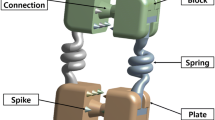Abstract
Recently, interspinous stabilization with Coflex-F implant has become an alternative to treat lumbar spinal stenosis (LSS). However, little attention focused on modifying the structure of the device to obtain the better clinic application. The purpose of this study was to design a new interspinous implant using topology optimization methods and evaluate its biomechanical performance. The finite element models of healthy lumbar spine and surgical lumbar spine with Coflex-F and Coflex-NEW (the new designed implant) were constructed. Finite element analysis was applied to each of the three models. The interspinous implant structure after topology optimization was remodeled at an 8% reduced volume compared with the Coflex-F device, and they can both provide stability in all motion at the surgical segment. Additionally, the advantage of Coflex-NEW was that it can decrease the von Mises stress of the implant structure in flexion, extension, torsion, and the spinous process in flexion, extension, and bending. The stress in spinous process with Coflex-NEW was well-distributed.

ᅟ







Similar content being viewed by others
References
Hartmann F, Dietz SO, Kuhn S, Hely H, Rommens PM, Gercek E (2011) Biomechanical comparison of an interspinous device and a rigid stabilization on lumbar adjacent segment range of motion. Acta Chir Orthop Traumatol Cech 78:404–409
Erbulut DU, Zafarparandeh I, Ozer AF, Goel VK (2013) Biomechanics of posterior dynamic stabilization systems. Adv Orthop 2013:1–6. https://doi.org/10.1155/2013/451956
Kim HJ, Kang KT, Chun HJ, Le CK, Chang BS (2015) The influence of intrinsic disc degeneration of the adjacent segments on its stress distribution after one-level lumbar fusion. Eur Spine J 24:827–837
Schwarzenbach O, Berlemann OU, Stoll TM, Gilles D (2005) Posterior dynamic stabilization systems: DYNESYS. Orthop Clin N Am 36:363–372
Lo CC, Tasi KJ, Chen SH, Zhong ZC, Hung CH (2011) Biomechanical effect after Coflex and Coflex rivet implantation for segmental instability at surgical and adjacent segments: a finite element analysis. Comput Method Biomech 14:969–978
Kettler A, Drumm J, Heuer F, Haeussler K, Mack C, Claes L, Wilke HJ (2008) Can a modified interspinous spacer prevent instability in axial rotation and lateral bending? A biomechanical in vitro study resulting in a new idea. Clin Biomech 23:242–247
Lo CC, Tasi KJ, Chen SH, Zhong ZC, Hung CH (2011) Biomechanical differences of Coflex-F and pedicle screw fixation combined with TLIF or ALIF—a finite element study. Comput Method Biomech 14:947–956
Park WM, Choi SK, Kim YH, Kim K (2014) Pre-tension effects from tightening the ligature on spinous process fracture risk in interspinous process device implantation. Int J Precis Eng Manuf 15:2597–2604
Zhong ZC, Wei SH, Wang JP, Feng CK, Chen CS, Yu CH (2006) Finite element analysis of the lumbar spine with a new cage using a topology optimization method. Med Eng Phys 28:90–98
Lin HM, Liu CL, Pan YN, Huang CH, Shih SL, Wei SH, Chen CS (2014) Biomechanical analysis and design of a dynamic spinal fixator using topology optimization: a finite element analysis. Med Biol Eng Comput 52:499–508
Panjabi MM, Chen NC, Shin EK, Wang JL (2001) The cortical shell architecture of human cervical vertebral bodies. Spine 26:2478–2484
Guo LX, Teo EC, Lee KK, Zhang QH (2005) Vibration characteristics of the human spine under axial cyclic loads: effect of frequency and damping. Spine 30:631–637
Polikeit A, Ferguson SJ, Nolte LP, Orr TE (2003) Factors influencing stresses in the lumbar spine after the insertion of intervertebral cages: finite element analysis. Eur Spine J 12:413–420
Schmidt H, Kettler A, Heuer F, Simon U, Claes L, Wilke HJ (2007) Intradiscal pressure, shear strain, and fiber strain in the intervertebral disc under combined loading. Spine 32:748–755
Goel VK, Kim YE, Lim TH, Weinstein JN (1988) An analytical investigation of the mechanics of spinal instrumentation. Spine 13:1003–1011
Sharma M, Langrana NA, Rodriguez J (1995) Role of ligaments and facets in lumbar spinal stability. Spine 20:887–900
Yamamoto I, Panjabi MM, Crisco T, Oxland T (1989) Three-dimensional movements of the whole lumbar spine and lumbosacral joint. Spine 14:1256–1260
Panjabi MM, Oxland TR, Yamamoto I, Crisco JJ (1994) Mechanical behavior of the human lumbar and lumbosacral spine as shown by three-dimensional load-displacement curves. J Bone Joint Surg Br 76:413–424
Chen CS, Cheng CK, Liu CL, Lo WH (2001) Stress analysis of the disc adjacent to interbody fusion in lumbar spine. Med Eng Phys 23:483–491
Zhong ZC, Chen SH, Hung CH (2009) Load- and displacement-controlled finite element analyses on fusion and non-fusion spinal implants. Proc Inst Mech Eng H 223:143–157
Kabir SMR, Gupta SR, Casey ATH (2010) Lumbar interspinous spacers—a systematic review of clinical and biomechanical evidence. Spine 35:E1499–E1506
Xu C, Ni WF, Tian NF, Hu XQ, Li F, Xu HZ (2013) Complications in degenerative lumbar disease treated with a dynamic interspinous spacer. Int Orthop 37:2199–2204
Bae HW, Davis RJ, Lauryssen C, Leary S, Maislin G, Musacchio MJ (2016) Three-year follow-up of the prospective, randomized, controlled trial of coflex interlaminar stabilization vs instrumented fusion in patients with lumbar stenosis. Neurosurgery 79:169–180
Chung KJ, Hwang YS, Koh SH (2009) Stress fracture of bilateral posterior facet after insertion of interspinous implant. Spine 34:E380–E383
Binder DK, Schmidt MH, Weinstein PR (2002) Lumbar spinal stenosis. Semin Neurosci 22:157–165
Funding
This study was supported with grants from the National Natural Science Foundation of China (51275082, 11272273).
Author information
Authors and Affiliations
Corresponding author
Ethics declarations
Conflict of interest
The authors declare that they have no conflict of interest.
Rights and permissions
About this article
Cite this article
Guo, LX., Yin, JY. Finite element analysis and design of an interspinous device using topology optimization. Med Biol Eng Comput 57, 89–98 (2019). https://doi.org/10.1007/s11517-018-1838-8
Received:
Accepted:
Published:
Issue Date:
DOI: https://doi.org/10.1007/s11517-018-1838-8




